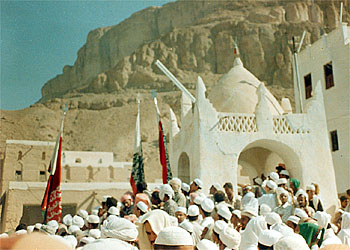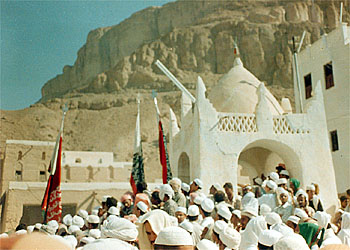
Flash of Insight Into a Unique Spiritual Journey: Hadramaut’s Ziyara Al Nebi Hud Festival [Archives:2001/07/Culture]
February 12 2001
By: Karen Dabrawska
Yemen Times
Peter Sanders is the first man to photograph the annual Ziyara Al Neb Hud Festival in a remote part of Hadramaut. But this humble, unassuming convert to Islam, who has taken over 100,000 photographs in 22 countries, is not interested in international acclaim: his life is centered around a spiritual journey of discovery.
‘I wanted to go to this festival, which is like a mini hajj, for about five years’, Sanders told The Yemen Times. His dream came true in 1998 when he combined a trip to the Prophet Hud’s burial place with an assignment for Aramco World about gamariyas, characterized by round windows, glazed with very thinly cut alabaster panels used instead of glass.
‘It is a five-day event in a place, which is only inhabited at the time of the festival. I was impressed by the behavior of the people. They were very devout and sincere and there is something very beautiful about the place. You feel that the stars are so close you can touch them’.

Hud was a pre-Islamic prophet. He lived among the people of Ad, who inhabited an area between Yemen and Oman. They were renowned for their craftsmanship, especially the construction of tall buildings with lofty towers. Political power was in the hands of unjust rulers against whom no one dared raise a voice.
According to the Bible and the Quran, God wanted to guide and discipline these people. So he sent them a prophet, Hud, who undertook his mission with great resoluteness and tolerance.
Some traditions claim that Hud was the first person who spoke Arabic but this has also been attributed to Noah and Adam.
Hud condemned idol worship: ‘My people! what is the benefit of these stones that you carve with your own hands and worship? In reality it is an insult to the intellect. There is only one deity worthy of worship and that is Allah. Worship of Him and Him alone is compulsory’.
The people mocked Hud, but he affirmed his dependence on Allah, realizing that the non-believers would be punished.
First came drought and then the weather changed suddenly from burning dry and hot to stinging cold. Hud’s people started to flee. The Quran tells us that: ‘As for Ad, they were destroyed by a furious violent wind, which Allah imposed on them for seven nights and eight days in succession, so that you could see men lying as if they were the hollow trunks of palm trees’.
The violent gale did not stop until the entire region was reduced to ruins and its wicked people destroyed, swallowed by the sands of the desert. Only Hud and his followers remained unharmed. They migrated to Hadramaut and lived there in peace, worshipping Allah. But Hud’s luck did not last long. He was persecuted once again and forced to flee. As his enemies were about to catch and kill him an enormous rock opened up and swallowed him. The rock is a place of pilgrimage where the festival has been held for centuries.
Sanders’ introduction to Yemen came from the people he met in Saudi Arabia. During the 1970s he took some of the first photographs of the hajj. ‘I met many Yemenis, was drawn to the people and wanted to visit their country: the Yemenis are wonderful people, generous to a fault’. Sanders is now planning a book about the Ziyara Al Nebi Hud Festival. It will be his second publication. The first ‘In the Shade of the Tree’ a collection of his work, is about to go to press. In the Shade of the Tree was also the name of his most recent exhibition held last month at London University’s Brunei Gallery.
From the city of the Dead to the city of Light from two million pilgrims on the hajj to the no-man’s land of the Empty Quarter, from the anguish of starving refugees to the industrial boom of Saudi Arabia, Sander’s photography opens the door to the unique, exotic lands of the Middle East, Africa, India, Central Asia and the vast lands of Islam.
The photographer has received many requests for the exhibition to be held at different venues, some as far afield as Singapore.
Reflecting on his career as a photographer, which started in the mid 1960s covering London’s seminal rock and roll scene, Sanders considers himself very fortunate to have been given permission to take pictures of spiritual figures who have never been photographed. ‘It’s partly because I am a Muslim, but people trust me as they sense I don’t want to exploit them. I just want to show the beauty of the sacred and capture a quality of innocence that seems to be disappearing’.
In 1970, Peter Sanders spent seven months travelling around India. ‘I grew up in London during the 60s. It was a time of rejecting the materialistic values of the Victorian period and searching for spiritual ways and paths to counter materialism. I travelled to India, studied all the religions and felt guided to Islam’.
Saudi Arabia was the next stop after India. Sander’s photographs of the hajj were sold world-wide and appeared in The Sunday Times, The Observer, Paris Match, Stern and Europa Magazine. His next trip took him to Morocco, Algeria, Turkey, Libya and Spain and there was also a ‘West to East’ trip across America. In 1988 Sanders was commissioned by a large aid agency to travel to West Africa, Senegal, Mauritania and Mali. He established the Peter Sanders Photographic Library, specializing in the Islamic World. His clients now include many international publishers, among them Longmans, Heinemann, Cambridge and Oxford University Press, Harper Collins, Readers Digest,
Hodder & Stoughton and Encyclopedia Britannica. His most recent trip was to China, including inner Mongolia, to document Muslims in the eastern region.
Sanders is equally at home in the East and in the West. His house in Amersham, on the outskirts of London resembles a Yemeni house. Cushions on the floor have replaced sofas, the decor is oriental and a sophisticated computer is on hand to show his best photos.
‘My photography has always been an extension of my life’, Sanders explains when introducing his latest exhibition.
‘Photography is a wonderful process – a gift from God – that has allowed me to learn so much about myself and the world around me. It’s like chasing a moment, trying to capture a beautiful bird in flight’.
The Japanese art critic, Tsuyoshi Kawasoe, said Sanders photos are extremely, extraordinarily beautiful. ‘He captures the spiritual beauty of creation itself’.
——
[archive-e:07-v:2001-y:2001-d:2001-02-12-p:./2001/iss07/culture.htm]


